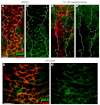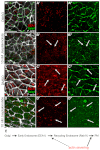Cofilin and Vangl2 cooperate in the initiation of planar cell polarity in the mouse embryo
- PMID: 23406901
- PMCID: PMC3585660
- DOI: 10.1242/dev.085316
Cofilin and Vangl2 cooperate in the initiation of planar cell polarity in the mouse embryo
Abstract
The planar cell polarity (PCP; non-canonical Wnt) pathway is required to orient the cells within the plane of an epithelium. Here, we show that cofilin 1 (Cfl1), an actin-severing protein, and Vangl2, a core PCP protein, cooperate to control PCP in the early mouse embryo. Two aspects of planar polarity can be analyzed quantitatively at cellular resolution in the mouse embryo: convergent extension of the axial midline; and posterior positioning of cilia on cells of the node. Analysis of the spatial distribution of brachyury(+) midline cells shows that the Cfl1 mutant midline is normal, whereas Vangl2 mutants have a slightly wider midline. By contrast, midline convergent extension fails completely in Vangl2 Cfl1 double mutants. Planar polarity is required for the posterior positioning of cilia on cells in the mouse node, which is essential for the initiation of left-right asymmetry. Node cilia are correctly positioned in Cfl1 and Vangl2 single mutants, but cilia remain in the center of the cell in Vangl2 Cfl1 double mutants, leading to randomization of left-right asymmetry. In both the midline and node, the defect in planar polarity in the double mutants arises because PCP protein complexes fail to traffic to the apical cell membrane, although other aspects of apical-basal polarity are unaffected. Genetic and pharmacological experiments demonstrate that F-actin remodeling is essential for the initiation, but not maintenance, of PCP. We propose that Vangl2 and cofilin cooperate to target Rab11(+) vesicles containing PCP proteins to the apical membrane during the initiation of planar cell polarity.
Figures








Similar articles
-
Planar cell polarity enables posterior localization of nodal cilia and left-right axis determination during mouse and Xenopus embryogenesis.PLoS One. 2010 Feb 2;5(2):e8999. doi: 10.1371/journal.pone.0008999. PLoS One. 2010. PMID: 20126399 Free PMC article.
-
Translation of anterior-posterior polarity into left-right polarity in the mouse embryo.Curr Opin Genet Dev. 2010 Aug;20(4):433-7. doi: 10.1016/j.gde.2010.04.002. Epub 2010 May 1. Curr Opin Genet Dev. 2010. PMID: 20439159 Review.
-
Planar cell polarity breaks bilateral symmetry by controlling ciliary positioning.Nature. 2010 Jul 15;466(7304):378-82. doi: 10.1038/nature09129. Epub 2010 Jun 20. Nature. 2010. PMID: 20562861 Free PMC article.
-
SEC14 and spectrin domains 1 (Sestd1) and Dapper antagonist of catenin 1 (Dact1) scaffold proteins cooperatively regulate the Van Gogh-like 2 (Vangl2) four-pass transmembrane protein and planar cell polarity (PCP) pathway during embryonic development in mice.J Biol Chem. 2013 Jul 12;288(28):20111-20. doi: 10.1074/jbc.M113.465427. Epub 2013 May 21. J Biol Chem. 2013. PMID: 23696638 Free PMC article.
-
The bidirectional relationship between cilia and PCP signaling pathway core protein Vangl2.Sci Prog. 2025 Jan-Mar;108(1):368504241311964. doi: 10.1177/00368504241311964. Sci Prog. 2025. PMID: 39819247 Free PMC article. Review.
Cited by
-
Intracellular Golgi Complex organization reveals tissue specific polarity during zebrafish embryogenesis.Dev Dyn. 2016 Jun;245(6):678-91. doi: 10.1002/dvdy.24409. Epub 2016 May 3. Dev Dyn. 2016. PMID: 27043944 Free PMC article.
-
Convergent extension in mammalian morphogenesis.Semin Cell Dev Biol. 2020 Apr;100:199-211. doi: 10.1016/j.semcdb.2019.11.002. Epub 2019 Nov 13. Semin Cell Dev Biol. 2020. PMID: 31734039 Free PMC article. Review.
-
Wnt11b is involved in cilia-mediated symmetry breakage during Xenopus left-right development.PLoS One. 2013 Sep 13;8(9):e73646. doi: 10.1371/journal.pone.0073646. eCollection 2013. PLoS One. 2013. PMID: 24058481 Free PMC article.
-
The Cilium: Cellular Antenna and Central Processing Unit.Trends Cell Biol. 2017 Feb;27(2):126-140. doi: 10.1016/j.tcb.2016.08.002. Epub 2016 Sep 12. Trends Cell Biol. 2017. PMID: 27634431 Free PMC article. Review.
-
Morphogenesis of the mouse neural plate depends on distinct roles of cofilin 1 in apical and basal epithelial domains.Development. 2015 Apr 1;142(7):1305-14. doi: 10.1242/dev.115493. Epub 2015 Mar 5. Development. 2015. PMID: 25742799 Free PMC article.
References
-
- Bastock R., Strutt H., Strutt D. (2003). Strabismus is asymmetrically localised and binds to Prickle and Dishevelled during Drosophila planar polarity patterning. Development 130, 3007–3014 - PubMed
-
- Bellomo D., Lander A., Harragan I., Brown N. A. (1996). Cell proliferation in mammalian gastrulation: the ventral node and notochord are relatively quiescent. Dev. Dyn. 205, 471–485 - PubMed
-
- Blair A., Tomlinson A., Pham H., Gunsalus K. C., Goldberg M. L., Laski F. A. (2006). Twinstar, the Drosophila homolog of cofilin/ADF, is required for planar cell polarity patterning. Development 133, 1789–1797 - PubMed
Publication types
MeSH terms
Substances
Grants and funding
LinkOut - more resources
Full Text Sources
Other Literature Sources
Molecular Biology Databases
Miscellaneous

